
Anno 401 - 500

|
Popes on Parade Anno 401 - 500 |
POPshop |
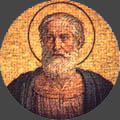 |
Saint Anastasius IAnno 399-401 |
An Italian from Rome. Anastasius had the singular misfortune of being Pope during the beginning of the barbarian invasions of the West. While the brittle Imperial frontier was showing its first cracks, Anastasius frittered away his time. He allowed himself to be convinced by his friend St. Jerome to condemn the writings of the third century theologian Origen, sight unseen. |
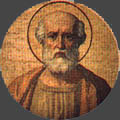 |
Saint Innocent IAnno 402-417 |
A Roman, possibly the son of Pope Anastasius I. He was unanimously chosen Pope by the people and clergy. Pope Innocent enjoyed a high point in the power and prestige of the Papacy. He answered appeals and questions from bishops as far away as Toulouse and Macedonia. Even Patriarch St. John Chrysostom of Constantinople, driven from his see by the Empress Eudoxia, sought Pope Innocent's advice and protection. St. Augustine appealed to Innocent to move against the trouble-making theologian Pelagius. He did so, and Pelagius submitted to Innocent's authority. Heresy was everywhere in retreat. All was not tea and cakes, however. The Goths (remember them?) under their King Alaric broke through what was left of the Imperial lines and invaded Italy. In AD 410, after an abortive peace effort by both Innocent and Emperor Honorius at Ravenna, the Goths put Rome itself to siege. They took the city and sacked it. For three days the Visigoths pillaged the eternal city. Luckily, Alaric was a Christian and was persuaded to spare the Churches, but pagan Rome was largely destroyed. |
 |
Saint ZosimusAnno 417-418 |
A Greek, possibly a converted Jew. Son of Abram. Amidst the ruins of Rome, Pelagianism continued to rear its ugly head, even though its architect had repudiated it. While consulting the African bishops on this issue, Zosimus managed to insult them by agreeing to hear the appeal of an excommunicated priest who had jumped the chain of command to appeal directly to the Pope. Zosimus issues a passal of decrees, including a hugely unpopular one forbidding priests from frequenting taverns. |
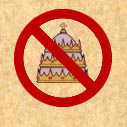 |
Eulalius(Antipope) |
Eulalius has the distinction of having the silliest name of any Pope or antipope. After the death of Pope Zosimus, a small group of Roman deacons got together, seized the Lateran, and elected the Archdeacon Eulalius as Pope. When the higher clergy tried to enter, the deacons chased them away with big sticks. The next day the bishops and clergy elected the ancient and slightly doddering Boniface, a nice enough guy who had the good sense to initially refuse election. The bishops insisted, and once again there were two Popes. Acting on bad information, the Emperor Honorius initially confirmed Eulalius. |
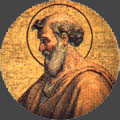 |
Saint Boniface IAnno 418-422 |
An Italian from Rome. Son of the presbyter Jocundus. Elected very much against his will (and in the face of the illegal election of the antipope Eulalius), the decrepit but holy Boniface gamely made a go at the Papacy. Appeals to the Emperor resulted in both Popes being exiled from Rome awaiting the verdict of a council of Western Bishops. Eulalius, however, couldn't stay away and returned early to stir up a mob to retake the Lateran. Imperial troops stepped in to disperse the mob, and a more-than-slightly-miffed Emperor Honorius immediately ruled for Boniface. Boniface with difficulty resolved the dispute with the African bishops, who submitted to papal authority. |
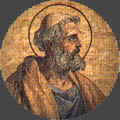 |
Saint Celestine IAnno 422-432 |
An Italian from Campagna; son of Priscus. He served as Archdeacon of Rome under Pope Boniface. Celestine was a friend of St. Augustine. He inherited a strong church, and he needed it. Barbarians rampaged through the ruins of the western Empire, and the Church and State were powerless to stop them. To the heretical roster of Manichaeans, Donatists, Noviatians, and Pelagians we must now add a new group: the Nestorians. The followers of Patriarch Nestorius of Constantinople claimed Christ was, in essence, two people: a human one and a divine one, and that the Virgin Mary could therefore only be called mother of Jesus, and not mother of God. The Ecumenical Council of Ephesus condemned Nestorius and his heresy, but it was a long time before his followers were brought to heel. The last official act of Celestine was the sending of St. Patrick to Ireland. |
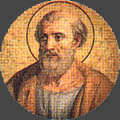 |
Saint Sixtus IIIXystus |
An Italian from Rome. Prior to his election, he was a close friend of St. Augustine. Sixtus dealt with the Nestorian and Pelagian heresies as best he could, trying to work out an accomodation which earned him the hatred of the ultra-orthodox in Rome. He built or restored a number of important Roman churches. |
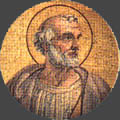 |
Saint Leo I |
An Italian from Rome, Leo was the first "Great" Pope. The Deacon Leo was on a diplomatic mission in Gaul when Pope Sixtus III died. Proving once again the adage that one should never miss an important committee meeting, particularly when there's a nasty job that nobody wants, the clergy and people elected the absent Leo as Pope. While the Western Empire disintgrated under the relentless invasions of the Germanic barbarians and the Eastern Empire was besieged with heresy and strife, the initially reluctant Leo resolved to defend Christendom and orthodoxy as best he could. He didn't demand Papal supremacy so much as assume it. He removed suspect bishops and condemned the slightest deviation from the received teaching. Yet even those condemned by him never found him arrogant or imperious. He saw himself as a universal pastor, and he taught and preached accordingly, all the while maintaining a strict ecclesiastical discipline. Such was Leo's personal authority, that the Council of Chalcedon in 451 proclaimed his Dogmatical Epistle to Flavian as the definitive Church teaching, even though Leo himself wasn't there to present it. In 452, when Attila's Hunnish armies were attacking anything that moved in northern Italy, Leo rode out to Mantua to meet him. The two men met together; what Leo said no man knows, but afterwards Attila withdrew his army. In 455 the Vandals under Genseric captured Rome. Somehow, Leo exacted a promise from Genseric that the city would not be sacked and that the lives of the inhabitants would be spared. Leo adapted the Church to the new barbarian kingdoms now squatting amidst the ruins of the Empire. When the Vandals established their realm in what was once Roman Africa, Leo energetically reorganized the episcopate there to take account of the new conditions. As well as a deeply spiritual man, Leo was a prolific writer; no less than 96 of his sermons and some 143 letters have survived. When he died, having been Pope for 21 years, the Church was much poorer for his death. |
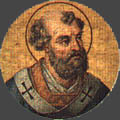 |
Saint HilarusAnno 461-468 |
A Sardinian. Hilarus was Archdeacon of Rome at the time of his election to the Papacy. Hilarus continued the strong approach of Saint Leo, at one point even upbraiding the Emperor Anthemius for consorting with heretics. Around him, the Western Roman Empire was reduced to a handful of towns in central and northern Italy. The future of civilization looked pretty grim. |
 |
Saint SimpliciusAnno 468-483 |
An Italian from Tivoli. Son of Castinus. It was during the long, sad pontificate of Simlicius that the Roman Empire of the West came to its quiet end. Odoacer, King of the Heruli Germans and an Arian heretic, deposed the last Emperor, Romulus Augustulus, on 4 September, 476. Hereafter, the eastern remnants of the Empire are known in the west as the Byzantine Empire. Welcome to the Dark Ages. Increasingly, the Patriarchs of Constantinople, backed by the Byzantine Emperors, began claiming the authority and prerogatives traditionally reserved to the Roman see. The Pope's voice in the east grew fainter. In the west, Simplicius vigourously maintained Catholic orthodoxy, quite a feat considering the confusion of the Germanic Migrations through Europe and the rule in Italy of the heretic Odoacer. Have I mentioned that the future of civilization was looking pretty grim? |
 |
Saint Felix III (II)Anno 483-492 |
Born of an aristocratic Roman family, Felix was the descendent of Senators. A widower when elected, he had at least two children, the ancestors of Popes Agapitus I and Gregory the Great. The situation in the Church was grim, grim, grim. The "King" of Italy was an Arian heretic, as were the Vandal Kings of northern Africa. Patriarch Acacius of Constantinople was merrily replacing orthodox bishops in the east with notorious heretics. Papal envoys investigating the Patriarch were arrested by the Emperor. Fed up, the Pope excommunicated Acacius, beginning a schism that would last more than thirty years. |
 |
Saint Gelasius IAnno 492-496 |
Of African parentage, Gelasius was born in Rome. The schism grew worse as both sides became entrenched in the views and increasingly abusive in their language. Theodoric the Ostrogoth seized power in Italy, cementing barbarian control of the West. Although an Arian, Theodoric had a strictly hands-off approach to religion. Gelasius was pretty much left to his own devices in governing the (Western) Church. Gelasius lived an extremely modest life as Pope. He died flat broke, having given all his possessions to the poor. |
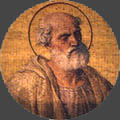 |
Saint Anastasius IIAnno 496-498 |
A Roman. In an effort to end the schism, Anastasius tried to compromise with the Patriarch of Constantinople. Unfortunately, as a diplomat Anastasius was inept. Pretty much all he succeded in doing was setting off an internal schism within the city of Rome. Now that takes talent. When Anastasius suddenly dropped dead, quite a number of people on both sides of the issue attributed it to the wrath of God. Centuries later, Dante consigned him to hell in his Inferno. Yet, somehow, Anastasius was later regarded as a saint. Go figure. |
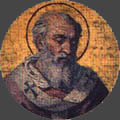 |
Saint SymmachusAnno 498-514 |
A Sardinian. The last convert from Paganism to become Pope, Symmachus was a deacon before his election. As part of the legacy of Anastasius, each of the two factions of the Roman schism elected their own Pope. Symmachus, the candidate of the hardliners, was elected first. Later that day, backed by funds from a rich Senator named Festus (I am not making this up), the Roman archpresbyter Laurentius was elected by the pro-reconciliation faction. Thes usual rioting started almost immediately, and King Theodoric was called in to settle the issue. He chose for Symmachus on the theory that he'd been elected first. Laurentius agreed to abide by the decision, and the undisputed Pope Symmachus invested him as bishop of Nocera in Campania. This brings us to the year 499... |
 |
Laurentius(Antipope) |
By all accounts, Laurentius was enjoying his tenure as bishop of Nocera, but the pro-Byzantine party in Rome, led by Senators Festus and Probinus, hadn't given up. In 501, they jumped on Pope Symmachus for an error on the date of Easter. They appealed to Theodoric, and Symmachus was called before a Roman Synod to explain himself. Meanwhile, the pro-Byzantine faction, riled up by wild accusations of Papal whoring and gambling, had stormed the Lateran and re-installed Laurentius as Pope. Symmachus, on his way to the synod, was attacked and several of his deacons were killed. Despite the fact that the Pope refused to leave his Vatican home after this, the synod found him innocent of all charges. Theodoric, initally disposed to allowing the both of them to be Popes if they wanted, finally sided with Symmachus. Laurentius was "retired" to the country estates of Senator Festus. |
Complete List of Popes
First Century |
Second Century |
Third Century |
Fourth Century |
Fifth Century
Sixth Century |
Seventh Century |
Eighth Century |
Ninth Century |
Tenth Century
Eleventh Century |
Twelfth Century |
Thirteenth Century |
Fourteenth Century |
Fifteenth Century
Sixteenth Century |
Seventeenth Century |
Eighteenth Century |
Ninteenth Century |
Twentieth Century
Twenty-First Century
Ecumenical Councils | Papal Box Scores